
Magadan is a port town and the administrative centre of Magadan Oblast, Russia. The city is located on the isthmus of the Staritsky Peninsula by the Nagaev Bay; it serves as a gateway to the Kolyma region.
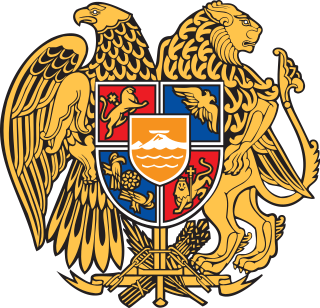
The national coat of arms of Armenia was adopted on April 19, 1992, by resolution of the Armenian Supreme Council. On June 15, 2006, the Armenian Parliament passed the law on the state coat of arms of Armenia.

Bryansk Oblast, also known as Bryanshchina, is a federal subject of Russia. Its administrative center is the city of Bryansk. As of the 2021 Census, its population was 1,169,161.

A cross pattée, cross patty or Pate, or cross paty, also known as a cross formy or cross formée or Templar cross, is a type of Christian cross with arms that are narrow at the centre, and often flared in a curve or straight line shape, to be broader at the perimeter. The form appears very early in medieval art, for example in a metalwork treasure binding given to Monza Cathedral by Lombard queen Theodelinda, and the 8th-century lower cover of the Lindau Gospels in the Morgan Library. An early English example from the start of the age of heraldry proper is found in the arms of Baron Berkeley.

The Emblem of Kazakhstan was adopted on 4 June 1992. The designers of the emblem are Jandarbek Melibekov and Shot-Aman Ualikhan. About 245 projects and 67 description designs of the future arms took part in the final competition. Like other post-Soviet republics whose symbols do not predate the October Revolution, the current emblem retains some components of the Soviet one, in this case, rising sun rays and star. Prior to 1992, Kazakhstan had an emblem similar to all other Soviet Republics.
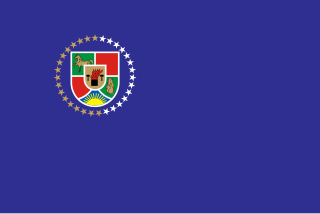
The flag of Luhansk Oblast is the official flag of Luhansk Oblast, an oblast in Ukraine. The oblast uses a cobalt flag charged with its coat of arms.

The flag of the Russian exclave of Kaliningrad Oblast is a rectangle with a ratio of 2:3 divided into three horizontal stripes. The upper stripe is red, a thin yellow stripe in the middle and a dark blue stripe of the same size as the red bar. In the canton is a silver-and-black stylized medieval castle with open gates and the monogram of Empress Elizabeth Petrovna.
This is a list of the Coats of arms of the Russian Federation and its federal subjects.
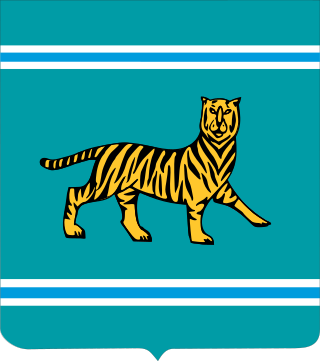
The coat of arms of the Jewish Autonomous Oblast is the official coat of arms of the Jewish Autonomous Oblast in Russia. It consists of a Siberian tiger standing on four legs with the tail and the head turned upwards, of which the latter is facing the observer. This specific position and occurrence of the tiger symbolizes the history and development of the Oblast. The coat is a heraldic French shield and the background represents the color of the geographical characteristics of the Russian Far East, which includes taigas, hills, and meadows.
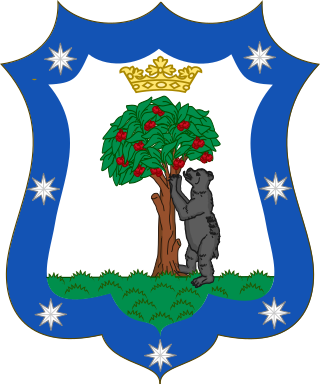
The bear as heraldic charge is not as widely used as the lion, boar or other beasts.

A representation of the sun is used as a heraldic charge. The most usual form, often called sun in splendour or in his glory, consists of a round disc with the features of a human face surrounded by twelve or sixteen rays alternating wavy and straight. The alternating straight and wavy rays are often said to represent the light and heat of the sun respectively.

The flag of Voronezh Oblast, a federal subject of Russia, was adopted 5 July 2005. The flag is a field of red, with a grouping of yellow rocks on the hoist side. Over the rocks, a liquid pours out of a turned-over white vase. It is also on the Voronezhan coat of arms. The ratio of the flag is 2:3.
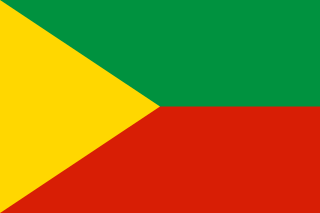
The flag of Zabaykalsky Krai, along with the coat of arms, is the official symbol of Zabaykalsky Krai, a federal subject of Russia.

The coat of arms of Carpatho-Ukraine is the official heraldic coat of arms of Zakarpattia Oblast in Ukraine. The coat of arms was initially adopted on 30 March 1920 along with coat of arms of other lands of Czechoslovakia. The Ukrainian version of the arms was adopted on 18 December 1990 as a revived coat of arms by Hungarian graphic artist Janos Reiti.

The flags of the subdivisions of Ukraine exhibit a wide variety of regional influences and local histories, reflecting different styles and design principles. Most local flags were designed and adopted after Ukrainian independence in 1991.

The flag of Kemerovo Oblast is a red rectangle with a blue stripe at the hoist side, its width 1/3 of the flag length. In the upper part of the blue stripe is the Kemerovo Oblast coat of arms. The coat of arms contains the year 1943, the year of the oblast's foundation, on a red Order of Lenin ribbon with gold edges. The emblem contains a pick axe and a hammer. The oblast is one of Russia's major coal and metal mining regions. The flag ratio is 1:2, however a variant used from 2003 is 2:3 ratio.

The flag of Vinnytsia Oblast is a flag which, together with the coat of arms, is the official symbol of the Vinnytsia Oblast, Ukraine. It was approved on July 18, 1997.

The Flag of Ossetia is a tricolor flag, top to bottom white, red, and yellow, used by the Ossetian people in Ossetia, a region spanning both sides of the Caucasus Mountains.

The flag of the Kherson Oblast is the official symbol of the Kherson Oblast of Ukraine, along with the coat of arms. Approved by the decision of the Kherson Regional Council No. 440 of 25 October 2001.
This is a list article about flags that have been used by pro-Russian separatists in Ukraine and in areas occupied by Russia and Russian-controlled forces during the Russo-Ukrainian War.


















